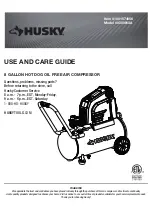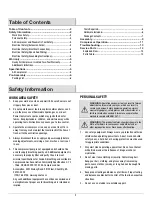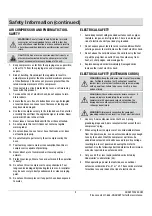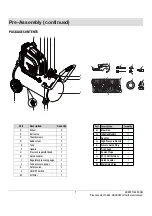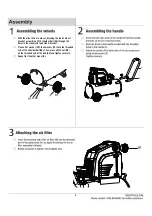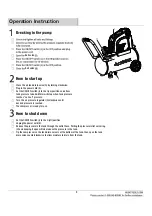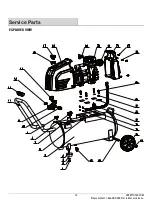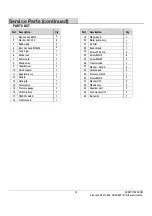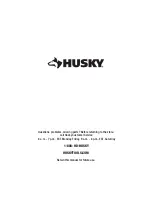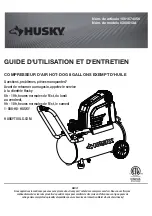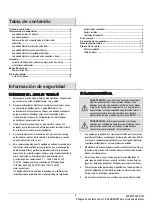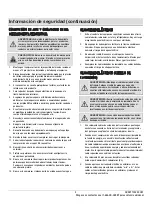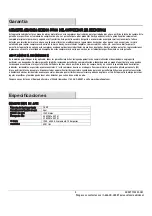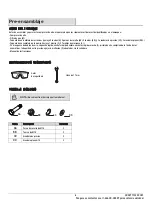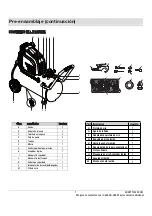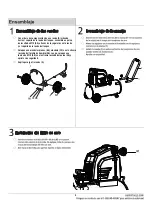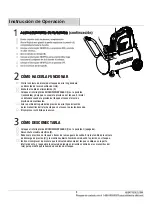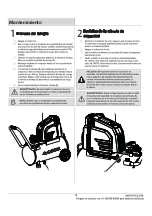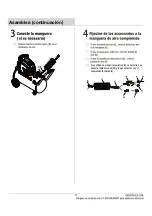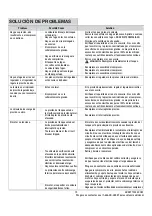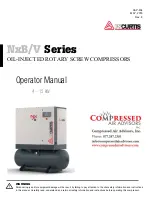
M
O
C
.
S
L
O
O
T
Y
K
S
U
H
.
e
c
n
a
t
s
i
s
s
a
r
e
h
t
r
u
f
r
o
f
Y
K
S
U
H
-
D
H
-
8
8
8
-
1
t
c
a
t
n
o
c
e
s
a
e
l
P
Troubleshooting
Problem
Possible Cause
Solution
There is low pressure, not
enough air, or the
compressor does not stop.
The tank drain valve is open.
There is a leak in the fittings.
There is a prolonged orexcessive
use of air.
The compressor is not large
enough.
There is a hole in the air hose.
The tank leaks.
The seals are blown.
The valve leaks.
There is a leaking or worn piston.
Close the drain valve.
Check fittings with soapy water. Tighten or reseal leaking
fittings DO NOT OVERTIGHTEN.
Decrease the amount of air used.
Check the air requirement of the accessory. If it is higher
than the CFM and the pressure supplied by the compressor,
you need a larger compressor. Most accessories are rated
at 25% of the actual CFM while running continuously.
Check and replace if necessary.
Immediately replace the tank. DO NOT
attempt to repair.
Replace the compressor assembly.
Replace the compressor assembly.
Replace the compressor assembly.
Air leaks from theregulator
or the regulator does not
regulate air pressure.
The internal parts of the regulator
are dirty or damaged.
Replace the regulator or internal parts.
The regulated pressure
gauge reading drops when
the air accessory is being
used.
This is normal.
The compressor is not large
enough.
If the pressure drops too low, adjust the regulator while
the accessory is used.
Check the air requirement of the accessory. If it is higher
than the CFM and the pressure supplied bythe compressor,
you need a larger compressor. Most accessories are rated
at 25% of the actual CFM while running continuously.
The pressure relief valve
opens.
The tank pressure exceeds the
normal rating pressure.
The pressure switch is stuck.
Replace the pressure switch.
Replace the pressure switch.
The motor will not run.
Tank pressure exceeds the
preset pressure switch limit.
The fuse is blown or the circuit
breaker tripped.
The check valve is stuck in the
open position.
The wire gauge in the cord is
wrong or the extension cord
length is excessive.
There are loose electrical
connections.
The motor’s thermal overload
protection has tripped.
The motor, capacitor or safety
valve is defective.
The motor will start automatically when the tank pressure
drops below the tank cut-in pressure.
Have the compressor serviced by a qualified technician.
Turn the air compressor off, unplug the power cord and
wait until the motor has cooled down. Plug in the power
cord only after the motor has cooled down, waiting at least
five minutes to make sure the thermal overload protector
has recovered.
Check for proper gauge and extension cord length.
Contact an authorized service center.
Remove and clean or replace.
Replace the blown fuse or reset the circuit breaker. Do not
use a fuse or circuit breaker with a higher rating than
specified for your branch circuit. Check for proper fuse;
type T fuse is acceptable. Check for low voltage and proper
extension cord size. Disconnect other applications from
the circuit. Operate the compressor on a dedicated circuit.
WARNING:
12

